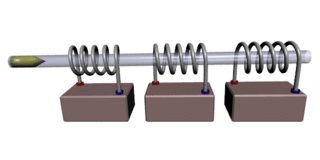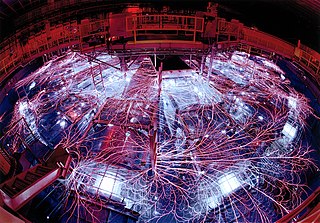Related Research Articles

An electromagnetic coil is an electrical conductor such as a wire in the shape of a coil. Electromagnetic coils are used in electrical engineering, in applications where electric currents interact with magnetic fields, in devices such as electric motors, generators, inductors, electromagnets, transformers, sensor coils such as in medical FMRi imaging devices with coils going upto 3-7 and even higher Tesla. Either an electric current is passed through the wire of the coil to generate a magnetic field, or conversely, an external time-varying magnetic field through the interior of the coil generates an EMF (voltage) in the conductor.

An electric motor is an electrical machine that converts electrical energy into mechanical energy. Most electric motors operate through the interaction between the motor's magnetic field and electric current in a wire winding to generate force in the form of torque applied on the motor's shaft. An electric generator is mechanically identical to an electric motor, but operates in reverse, converting mechanical energy into electrical energy.

In electricity generation, a generator is a device that converts motion-based power or fuel-based power into electric power for use in an external circuit. Sources of mechanical energy include steam turbines, gas turbines, water turbines, internal combustion engines, wind turbines and even hand cranks. The first electromagnetic generator, the Faraday disk, was invented in 1831 by British scientist Michael Faraday. Generators provide nearly all the power for electrical grids.

An electromagnet is a type of magnet in which the magnetic field is produced by an electric current. Electromagnets usually consist of wire wound into a coil. A current through the wire creates a magnetic field which is concentrated in the hole in the center of the coil. The magnetic field disappears when the current is turned off. The wire turns are often wound around a magnetic core made from a ferromagnetic or ferrimagnetic material such as iron; the magnetic core concentrates the magnetic flux and makes a more powerful magnet.

An alternator is an electrical generator that converts mechanical energy to electrical energy in the form of alternating current. For reasons of cost and simplicity, most alternators use a rotating magnetic field with a stationary armature. Occasionally, a linear alternator or a rotating armature with a stationary magnetic field is used. In principle, any AC electrical generator can be called an alternator, but usually the term refers to small rotating machines driven by automotive and other internal combustion engines.
An explosively pumped flux compression generator (EPFCG) is a device used to generate a high-power electromagnetic pulse by compressing magnetic flux using high explosive.

A coilgun is a type of mass driver consisting of one or more coils used as electromagnets in the configuration of a linear motor that accelerate a ferromagnetic or conducting projectile to high velocity. In almost all coilgun configurations, the coils and the gun barrel are arranged on a common axis. A coilgun is not a rifle as the barrel is smoothbore.

A synchronous electric motor is an AC electric motor in which, at steady state, the rotation of the shaft is synchronized with the frequency of the supply current; the rotation period is exactly equal to an integer number of AC cycles. Synchronous motors use electromagnets as the stator of the motor which create a magnetic field that rotates in time with the oscillations of the current. The rotor with permanent magnets or electromagnets turns in step with the stator field at the same rate and as a result, provides the second synchronized rotating magnet field. A synchronous motor is termed doubly fed if it is supplied with independently excited multiphase AC electromagnets on both the rotor and stator.

A Marx generator is an electrical circuit first described by Erwin Otto Marx in 1924. Its purpose is to generate a high-voltage pulse from a low-voltage DC supply. Marx generators are used in high-energy physics experiments, as well as to simulate the effects of lightning on power-line gear and aviation equipment. A bank of 36 Marx generators is used by Sandia National Laboratories to generate X-rays in their Z Machine.

A magnetic circuit is made up of one or more closed loop paths containing a magnetic flux. The flux is usually generated by permanent magnets or electromagnets and confined to the path by magnetic cores consisting of ferromagnetic materials like iron, although there may be air gaps or other materials in the path. Magnetic circuits are employed to efficiently channel magnetic fields in many devices such as electric motors, generators, transformers, relays, lifting electromagnets, SQUIDs, galvanometers, and magnetic recording heads.

Pulsed power is the science and technology of accumulating energy over a relatively long period of time and releasing it instantly, thus increasing the instantaneous power. They can be used in some applications such as food processing, water treatment, weapon, and medical applications.
This is an alphabetical list of articles pertaining specifically to electrical and electronics engineering. For a thematic list, please see List of electrical engineering topics. For a broad overview of engineering, see List of engineering topics. For biographies, see List of engineers.

A dynamo is an electrical generator that creates direct current using a commutator. Dynamos were the first electrical generators capable of delivering power for industry, and the foundation upon which many other later electric-power conversion devices were based, including the electric motor, the alternating-current alternator, and the rotary converter.

In electromagnetism, excitation is the process of generating a magnetic field by means of an electric current.

Resonant inductive coupling or magnetic phase synchronous coupling is a phenomenon with inductive coupling in which the coupling becomes stronger when the "secondary" (load-bearing) side of the loosely coupled coil resonates. A resonant transformer of this type is often used in analog circuitry as a bandpass filter. Resonant inductive coupling is also used in wireless power systems for portable computers, phones, and vehicles.
An explosive-driven ferroelectric generator is a compact pulsed power generator, a device used for generation of short high-voltage high-current pulse. The energies available are fairly low, in the range of single joules, the voltages range in tens of kilovolts to over 100 kV, and the powers range in hundreds of kilowatts to megawatts. They are suitable for delivering high voltage pulses to high-impedance loads and can directly drive radiating circuits.
A vector inversion generator (VIG) is an electric pulse compression and voltage multiplication device, allowing shaping a slower, lower voltage pulse to a narrower, higher-voltage one. VIGs are used in military technology, e.g. some directed-energy weapons, as a secondary stage of another pulsed power source, commonly an explosive-driven ferroelectric generator.

A magneto is an electrical generator that uses permanent magnets to produce periodic pulses of alternating current. Unlike a dynamo, a magneto does not contain a commutator to produce direct current. It is categorized as a form of alternator, although it is usually considered distinct from most other alternators, which use field coils rather than permanent magnets.
An electromagnetic pulse (EMP), also referred to as a transient electromagnetic disturbance (TED), is a brief burst of electromagnetic energy. The origin of an EMP can be natural or artificial, and can occur as an electromagnetic field, as an electric field, as a magnetic field, or as a conducted electric current. The electromagnetic interference caused by an EMP can disrupt communications and damage electronic equipment. An EMP such as a lightning strike can physically damage objects such as buildings and aircraft. The management of EMP effects is a branch of electromagnetic compatibility (EMC) engineering.
Electromagnetically induced acoustic noise, electromagnetically excited acoustic noise, or more commonly known as coil whine, is audible sound directly produced by materials vibrating under the excitation of electromagnetic forces. Some examples of this noise include the mains hum, hum of transformers, the whine of some rotating electric machines, or the buzz of fluorescent lamps. The hissing of high voltage transmission lines is due to corona discharge, not magnetism.
References
- ↑ Loki Incorporated - Specialists in Explosives, Propellants and Pyrotechnics Archived 2010-02-22 at the Wayback Machine . Lokiconsult.com. Retrieved on 2010-02-08.
- ↑ E-Bombs Could Go Mainstream. Aviation Week (2009-03-11). Retrieved on 2010-02-08.
- ↑ S.I. Shkuratov et al., Loki Incorporated, Rolla, MO 65409, U.S.A. "Explosive-driven mini-system based on shock wave ferromagnetic seed source and loop magnetic flux compression generator" Archived 2010-06-29 at the Wayback Machine
- ↑ Welcome to IEEE Xplore 2.0: Completely Explosive Autonomous High-Voltage Pulsed-Power System Based on Shockwave Ferromagnetic Primary Power Source and Spiral Vector Inversion Generator. Ieeexplore.ieee.org (2006-10-16). Retrieved on 2010-02-08.
- ↑ E.F. Talantsev et al. "Analytical Model for Explosive-Driven Ultracompact Shock-Wave Ferromagnetic Generators" Vol. 115 (2009) Acta Physica Polonica A No. 6, Proceedings of the 2nd Euro-Asian Pulsed Power Conference, Vilnius, Lithuania, September 22–26, 2008